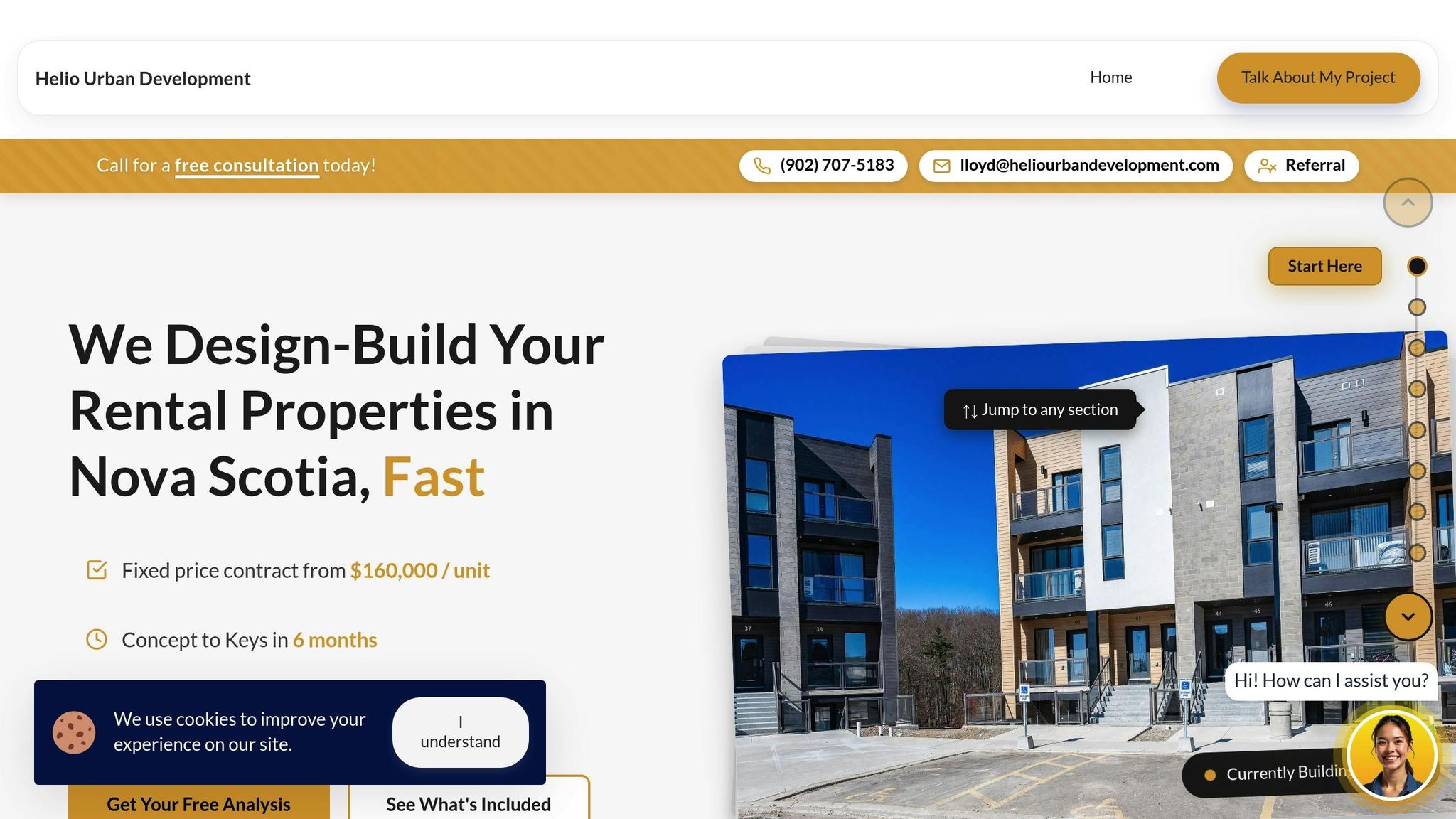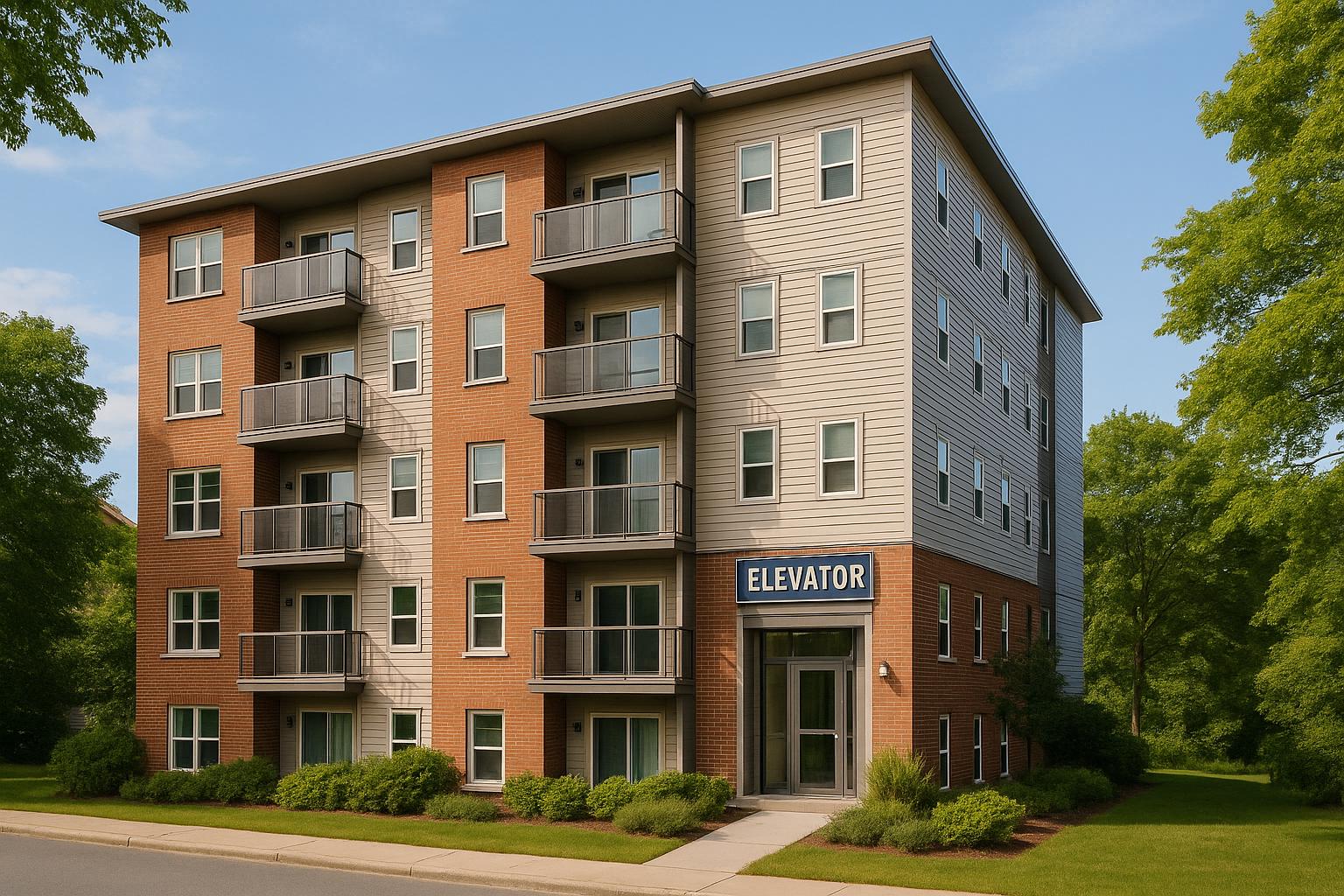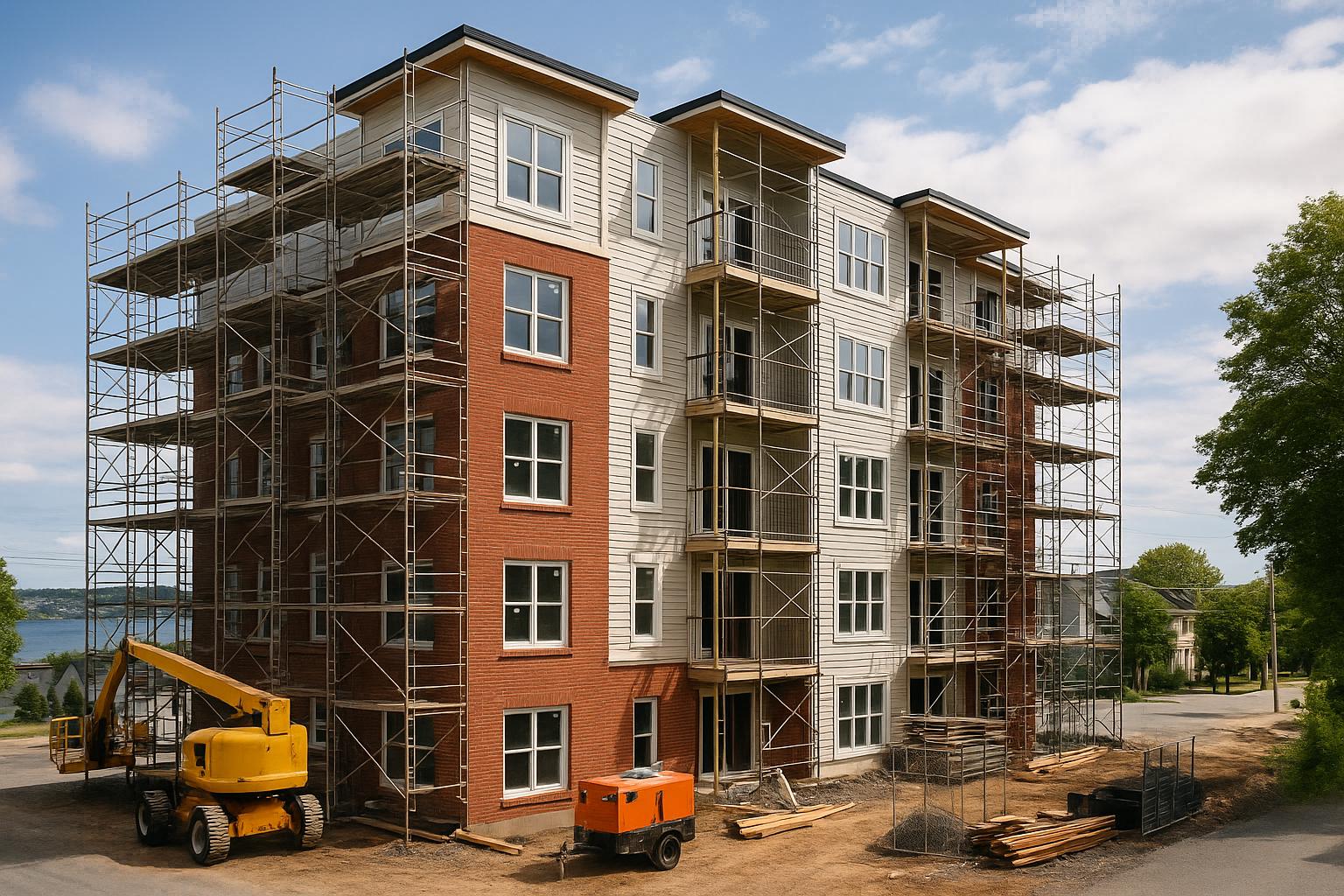When construction drags on, rental property owners lose money - fast. For a four-unit property in Nova Scotia, delays can cost up to $52,800 in lost rent over six months. Here’s why:
- Lost Income: Each unit rents for $2,200/month. Over six months, that’s $52,800 you’ll never recover.
- Carrying Costs: Loans, taxes, and insurance continue to pile up even without tenants - adding thousands more.
- Missed Opportunities: Delays mean you can’t capitalize on Nova Scotia’s lucrative rental market.
The solution? A 6-month construction timeline. Companies like Helio Urban Development guarantee on-time completion, ensuring you start earning sooner. Their design-build approach eliminates inefficiencies, consolidates accountability, and keeps projects on track.
Why Build-to-Rent is the Most Underrated Rental Strategy (Even in High-Interest Markets)
The Real Cost of Construction Delays: Calculating Lost Income
Every month that a construction project is delayed eats into potential rental income, pushes back wealth-building opportunities, and directly impacts your return on investment (ROI).
How Delays Translate to $52,800 in Lost Rent
Take a four-unit rental property in Nova Scotia as an example. At $2,000 per unit, the property generates $8,000 in monthly rental income. With a six-month construction timeline, you could start collecting rent by the seventh month, earning a total of $144,000 over the next 18 months (from month 7 to month 24).
But when construction takes longer, the financial impact grows. For an 18-month project, you lose 12 months of rental income - equivalent to $96,000 (12 months × $8,000). On average, a delay of 6.6 months results in $52,800 in lost rent.
According to research from the Construction Industry Institute, delays in construction projects typically fall between 20% and 30% of the original timeline [1]. To make matters worse, only 30% of contractors manage to complete projects on time and within budget [2]. This means many property owners are forced to absorb these significant financial setbacks.
More Than Lost Rent: The Hidden Costs of Delays
Lost rental income is just one piece of the puzzle. Construction delays bring additional costs that can quickly escalate:
- Financing Costs: A $640,000 loan at a 7% interest rate adds $3,733 in monthly interest payments. Over six months, that totals approximately $22,400 in extra financing costs.
- Carrying Costs: Even when the property isn't generating income, you're still on the hook for property taxes, insurance, and utilities. For a four-unit property, these costs typically range between $800 and $1,200 per month.
- Labour and Equipment: Delays mean paying for additional labour hours, extended equipment rentals, and increased supervision.
- Rising Material Prices: Delayed projects often face price hikes for materials, which can significantly inflate overall costs.
- Opportunity Costs: With your capital tied up in an incomplete project, you miss out on other investment opportunities or the ability to reduce debt faster.
When combined, these factors amplify the financial strain caused by delays.
"What we're trying to do is drive efficiencies and deliver greater predictability, so we can manage business risk." – James Eaton, Head of Digital Delivery, McLaren Construction Group [2]
In the U.S. alone, construction errors cost an estimated $273 billion annually [2]. This highlights how inefficient practices can have a massive financial impact.
Comparing Rental Income by Construction Timeline
To better understand the financial impact of delays, let's compare rental income based on different construction timelines for a four-unit property that generates $8,000 per month:
| Construction Timeline | Rent Collection Period (months) | Total Income (over 24 months) | Lost Income vs. 6-Month Build |
|---|---|---|---|
| 6-Month Build | 18 | $144,000 | $0 |
| 12-Month Build | 12 | $96,000 | $48,000 |
| 18-Month Build | 6 | $48,000 | $96,000 |
This table assumes all construction scenarios begin at the same time, with only the project duration - and thus the rent-collection period - differing. The faster construction is completed, the sooner rental income begins, reducing not only lost income but also the cascading costs outlined earlier.
These numbers highlight the importance of efficient construction practices. Up next, we’ll dive into how the design-build approach can help tackle these delays effectively.
Standard Construction vs. Design-Build: Key Differences
In Nova Scotia, property owners often grapple with fragmented contracts, communication delays, and unexpected costs when using traditional construction methods. These issues can lead to prolonged timelines and inflated budgets. In contrast, the design-build approach simplifies the process by combining design and construction under a single contract. Let’s explore the challenges of standard construction methods and how design-build provides a more efficient alternative.
Problems with Standard Construction Methods
Traditional construction requires property owners to juggle multiple contracts - one for each architect, engineer, general contractor, and subcontractor. This fragmented system often results in poor coordination, which directly impacts project costs and schedules.
Communication breakdowns and timeline setbacks are common. Miscommunication between different companies can lead to misunderstandings, errors, and rework. Workers may find themselves waiting on others to complete tasks, compounding delays.
"Inefficiencies in construction labour can arise from various sources, including poor planning, inadequate communication, lack of training, and ineffective use of technology." [4]
Budget overruns are another frequent issue. When contractors provide separate estimates, it’s not uncommon for final costs to exceed initial projections. For example, studies show that 10% of projects costing over $1 million experience budget overruns of more than 10% [3]. In 2022, U.S. contractors reportedly wasted between $30 billion and $40 billion due to inefficiencies in labour [4].
Finger-pointing is almost inevitable when accountability is spread across multiple contractors. Property owners often find themselves stuck in the middle of disputes, with no clear resolution.
How Design-Build Fixes These Problems
The design-build approach directly addresses these challenges by streamlining processes and consolidating accountability. Under this method, all team members - designers, engineers, and construction professionals - work together under one contract, fostering collaboration and shared responsibility.
Single point of responsibility ensures that everyone involved shares the same goals and works together to resolve issues, rather than assigning blame.
"Unlike the traditional design-bid build method, the design-build delivery method involves the designer and contractor working together from the beginning, as a team, providing unified project recommendations to fit the owner's schedule and budget." [7]
Integrated cost control is built into the process. From the outset, designs are aligned with the target budget, and costs are reviewed throughout the project. This approach can reduce project costs by up to 6.1% compared to traditional methods [9].
Faster completion is another advantage. By overlapping design and construction phases, design-build projects are completed an average of 33% faster than traditional methods [8].
Collaborative problem-solving replaces the adversarial dynamics often seen in standard construction. With a single entity responsible for both design and construction, disputes are minimized, and solutions are found more efficiently.
Standard vs. Design-Build Construction Comparison
The table below highlights the stark differences between traditional construction methods and the design-build approach:
| Factor | Standard Construction | Design-Build |
|---|---|---|
| Contracts | Multiple separate contracts | Single integrated contract |
| Timeline | 12–18 months typical | 6 months guaranteed |
| Budget Control | Cost-plus with overruns | Fixed price before groundbreaking |
| Accountability | Diffused responsibility | Single point of responsibility |
| Communication | Fragmented across companies | Unified team coordination |
| Problem Resolution | Blame shifting | Collaborative solution-finding |
| Quality Control | Inconsistent standards | Integrated quality systems |
Design-build projects consistently outperform traditional ones, with 3.8% less cost growth and 1.7% less schedule growth [6]. For example, a $640,000 four-unit project could save approximately $24,320 in costs, while reducing timeline risks. By integrating engineers, architects, and construction professionals, design-build fosters a collaborative environment that delivers better value, faster timelines, and greater trust among project teams [7].
This approach is rapidly gaining popularity across North America. Design-build now accounts for over 40% of all non-residential construction [7], and FMI Corporation forecasts it will represent over 47% of spending by 2028, with $2.6 trillion in construction spending projected from 2024 to 2028 [5].
For Nova Scotia property owners developing rental properties with four or more units, opting for design-build can significantly influence when rent collection starts - accelerating income generation and wealth-building opportunities.
sbb-itb-16b8a48
Helio Urban Development: Guaranteed On-Time Construction

Helio Urban Development, based in Nova Scotia, takes a streamlined approach to construction by combining planners, architects, engineers, and builders under one roof. This unified model eliminates the typical coordination headaches that often slow down projects.
Helio's 6-Month Construction Guarantee
Helio commits to delivering projects on time with a bold guarantee: construction completion within six months, backed by penalties of up to $1,000 per day for delays[10]. As co-founder and CEO Lloyd Liu puts it:
"I personally review every quote and guarantee every timeline."[10]
Their fixed-price contracts start at $160,000 per unit for standard construction or $200,000 per unit with the CMHC MLI Select option[10]. These contracts cover everything - labour, materials, and project management. To maintain quality, Helio includes five inspections by Professional Engineers (P.Eng) during construction and keeps clients updated with daily photo reports[10].
This level of accountability is reflected in their ongoing Halifax-area projects.
Local Results: Halifax Region Project Examples
Helio's track record speaks for itself. As of 26 June 2025, the company has 42 units under construction and 131 units in planning and design across Nova Scotia[11]. Some of their active projects in the Halifax region include:
- Downtown Truro: 6-unit project, expected completion January 2026
- Downtown Windsor: 8-unit project, expected completion December 2025
- Bridgewater: 6-unit project, expected completion January 2026
- Kentville: 6-unit project, expected completion February 2026[11]
With over 30 professionals working across eight job sites[11], Helio ensures projects stay on track. For property owners, this means rental income - ranging from $7,800 to $8,400 monthly for a 4-unit project - begins as soon as construction wraps up[10].
Scheduling Systems That Prevent Delays
Helio uses advanced scheduling tools to keep projects moving smoothly. Co-founder and CTO Yuan He explains:
"Our AI scheduling system eliminates the delays experienced during earlier projects."[11]
By using Civil 3D software, parametric design, and templates, Helio speeds up the planning process, achieving 30-day permit submissions and 90% first-pass municipal approvals[12]. Their integrated approach ensures that everyone - planners, architects, engineers, and contractors - works from the same playbook. This coordination helps identify and resolve potential bottlenecks before they become problems[11].
For property owners, Helio’s combination of fixed pricing, guaranteed timelines, and financial accountability provides peace of mind and ensures rental income starts right on schedule.
Conclusion: Maximize Returns with On-Time Construction
Finishing your construction project in just six months can save you $52,800 in lost rent for a 4-unit property. This immediate financial benefit, paired with tax deductions for eligible expenses that offset rental income, highlights the importance of sticking to a reliable, on-time construction plan.
The best way to avoid costly delays? Choosing the right construction approach. Property owners looking to safeguard their investment should focus on working with reputable service providers who have proven expertise. Insist on contracts that include liquidated damages clauses (penalties for delays) and hold regular project meetings with detailed schedules to keep everyone on track and accountable [13].
"Effective project management provides the structure, oversight, and strategic direction needed to guide a project from the start through to its completion - ensuring all stakeholders remain aligned and focused on delivering the client's vision."
A structured approach like this, supported by advanced scheduling systems and open communication channels, helps identify and resolve potential issues before they escalate into costly delays [14]. Tools like Helio's AI-driven scheduling system are a game-changer, enabling seamless coordination to ensure timelines are met.
For property owners in Nova Scotia, the decision is clear: ditch traditional methods that often lead to 30–60% budget overruns and delays. Instead, opt for integrated builders who guarantee six-month timelines and commit to financial penalties if they fall behind. The profitability of your rental property hinges on when construction is completed - not when it begins.
FAQs
How does the design-build method help prevent delays and save money compared to traditional construction?
The design-build method streamlines construction by merging the design and construction phases into one cohesive process. This integration accelerates timelines and improves coordination, cutting down on disruptions and expensive missteps along the way.
With one team overseeing the entire project, communication becomes more efficient, accountability is straightforward, and decisions are made faster. This setup reduces the chances of disputes, eliminates unnecessary rework, and keeps the project moving smoothly. By completing projects on time and sticking to a set budget, the design-build approach helps property owners save both time and money while ensuring the best possible outcome.
What financial risks could you face if your construction project takes longer than six months?
Delays in construction can bring serious financial risks for property owners. When timelines stretch out, costs can quickly pile up from overtime pay, extra supervision, and the hassle of rescheduling trades. All of this can push your project budget far beyond what you initially planned.
The ripple effects don’t stop there. Delays can also disrupt your cash flow, especially if they postpone rental income. Take this example: a 4-unit property with each unit renting for $2,200 per month could lose out on $52,800 in rental income over a six-month delay. These setbacks can take a big bite out of your return on investment (ROI), making it clear why finishing on time is so crucial to your bottom line.
How does Helio Urban Development guarantee on-time and on-budget completion for rental property construction projects?
Helio Urban Development takes pride in delivering projects on time and within budget by using a fixed-price contract and a guaranteed delivery model. This method not only keeps surprises at bay but also ensures a smooth, efficient process from beginning to end.
Here’s how they make it happen:
- Thorough planning: Important decisions are made early on, reducing the likelihood of expensive last-minute changes.
- Skilled project management: Their seasoned team keeps everything running like clockwork, ensuring tasks are coordinated and executed seamlessly.
- Weather-conscious scheduling: By factoring in local weather patterns, they create timelines that are both realistic and achievable.
With these strategies in place, property owners can sidestep the financial headaches of delays and focus on boosting their rental income potential.



